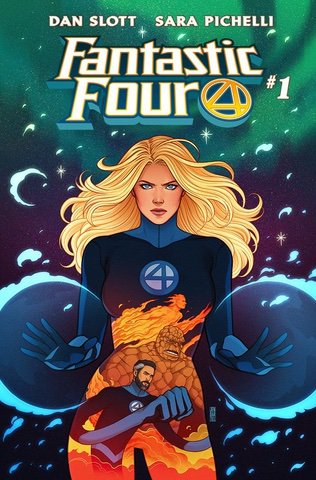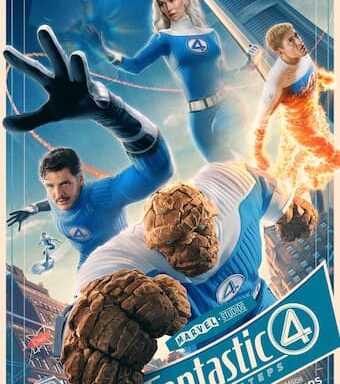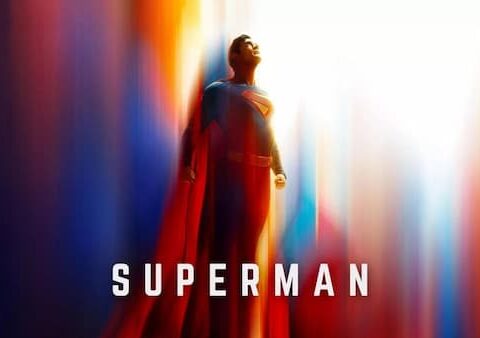We’ve been waiting for the proper return of the Fantastic Four for some time now.
While I was (mostly) enjoying the Marvel Two-in-One series with Ben and Johnny – and which was essentially a long build-up to this FF return – it’s about time to get there.
Three (or four?) years in the wilderness of the multiverse is quite enough. ‘The World’s Greatest Comic Magazine!’ the cover tells us in unabashed retro style, clearly showing the enthusiasm with which Marvel’s premier family-heroes are being brought back into the scene.
Fantastic Four #1 is divided into four different stories.
The first, ‘Signal in the Sky’ (by Dan Slott and Sara Pichelli) is a really good, sweet story told from the perspective of Johnny and Ben.
The whole thing is a misdirect: we’re shown Johnny at a football game, where he suddenly sees the Fantastic 4 signal blaze across the sky. He rushes off to meet it, believing that Reed, Susan and the kids have returned… only to find it’s a bunch of street kids who stole a flare- signal from FF property and set it off in the sky.
Meanwhile we see Ben asking Alicia to marry him, as he comes to terms with a life without Susan and Reed and makes plans for his future. What it all seems to build to is both of them coming to terms with the fact that their counterparts will never be returning and that they have to get on with their lives and stop waiting.
And then it is at that precise moment that we cut to Susan and Reed (wherever they are) preparing to establish contact with Earth – and we cut back to Johnny and Ben seeing the ‘signal in the sky’ for real this time: knowing that it means their friends are alive and coming home.
It’s a bit cheesy, sure. But it’s a sweet way to do this and it’s difficult not to like it.
The second piece, ‘Our Day of Doom and Victory’ (Dan Slott and Simone Bianchi) is perhaps even better, though very different. In this story, we find Doom returning to Latveria and his castle. We find the people in Latveria under foreign domination: and one loyalist finds her way into Doom’s castle after she sees a light go behind one of the windows for the first time in a long while.
This little story that unfolds is frankly superb.
I’m a Doctor Doom nut, of course: frankly he could be reading out the phone directory and I’d be compelled. But we get here is, seemingly the return of classic Doom to both his old home and his old self.
Which is both compelling and a bit of a shame – I was rather enjoying the Good Guy version of Doom we’ve been seeing lately. And yet it’s impossible to resist when you see old-school Doom reasserting itself here. This little piece – within just a few pages – is also really interesting in terms of exploring his relationship to his people. It’s clear, here, that they see him as their saviour, their hero – and that his return is what they’ve been waiting for.
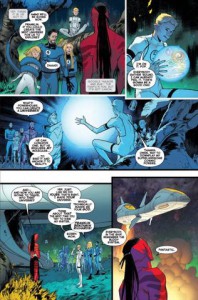
As much as I want to hold on to the Good Guy Doom longer, it’s so gratifying to see Doom put his mask back on (his “true face”, as she tells him) and go outside to take action against Latveria’s military occupiers. I almost got goosebumps.
I honestly can’t remember the last time I read a Doom story I didn’t entirely love: and this is no exception.
Fantastic Four #2 shifts us back to before Johnny and Ben see the signal in the sky: and also shifts us to the perspective of Reed, Susan and co, telling their story and how it leads to that signal being sent. This is a great narrative strategy: eventually, we get back to that same point – the signal being sent out and witnessed.
This is also what a lot of people have been waiting for for three years: a return to those characters and seeing what they’re up to. It’s hard not to feel warm and fuzzy about it: just getting Valeria Richards back is something I’ve been waiting for.
The story we get here follows Reed, Susan, Valeria, Franklin and the ‘Future Foundation’ at the tail end of their multiversal adventuring. It’s fun seeing all of this, the sense of what these guys have been up to in the three years (our time) since we’ve seen them: the idea of hopping universes and realities, getting into scrapes and having adventures, is enticing.
It makes me wonder why we didn’t get a whole series solely focused on Reed, Susan and these adventures in the multiverse. It could’ve been a really great volume of stories.
The idea of Franklin being so powerful he can casually ‘create universes’ seems a tad excessive to me: even though it was clearly laid out in the epilogue to 2015’s Secret Wars. I mean, hey, this is comic-book stuff – it shouldn’t be a problem, right? But, for some reason, I struggle with it a little.
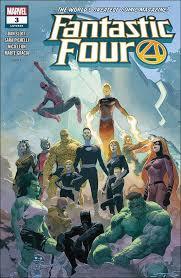
In this instance, however, we see there’s a price to be paid: as Franklin finds his powers waning and he soon learns that all of these universes he’s created are at risk of being deleted from existence by a mega-powerful entity called Entropy – or ‘The Griever at the End of All Things’. I kind of like this character: she’s more of a dark facet of the universal balance or something like that.
And she’s creepy: her minions (her “endlings”) are damn creepy too.
Putting aside a rather unceremonious death for the Molecule Man, what I kind of like here is the sense of universal balance: that what Franklin and the others have been doing so casually was some kind of violation of universal law, causing imbalance, and that ‘Entropy’ is both the comeuppance and the correction. We see images of worlds and people – presumably created by Franklin – being destroyed by her. The sense is that you can’t violate reality like that without consequence – a lesson that Franklin and his parents are now being forced to learn.
There are nice dynamics here: Susan’s anxiety over Reed admitting he doesn’t have a way to get them out of this, for example, or Valeria forcefully defying her father’s plan and implementing her own.
Reed’s last-ditch maneuver to give them a fighting chance is a fun one: allowing Entropy to let him signal the missing two members of the Fantastic Four on Earth. This brings us to the moment from the first book in which Johnny and Ben see the signal in the sky. Except this time we see Reed use his device to transport them physically to his location.
It’s a cool moment: but that’s not the twist. The bigger twist is that Reed has also transported over a whole bunch of other heroes too: T’Challa, Spiderman, Storm, Medusa, among others. It’s a great little reveal.
This sets up the conclusion in Fantastic Four #3, in which this array of Marvel characters helps the FF to try to outwit ‘Griever’ (‘Entropy’). There’s not a great deal to say about this. It gets a little cheesy in places, but it can be forgiven on account of this story essentially being the return of the Fantastic Four to the contemporary scene. It’s good that their victory here really doesn’t come down to power or fighting, but to Reed out-thinking the enemy: that’s more in keeping with how this has been going.
Other than that, it’s pretty much what you would expect. The Good Guys win: the FF are back and there’s a wedding on the horizon. There are some nice little touches here too, such as Spiderman’s attempted pep-talk with Franklin.
Again, it’s hard not to feel good about the FF returning: and that allows this book to pretty much coast. My one lingering criticism would be that this business of Franklin being responsible for the mass extinctions of entire planets and societies (becasue the Griever has undone everything Franklin has created) feels like it’s being glossed over a little too quickly. I hope they deal with this more going forward, because it’s a pretty huge issue.
Fantastic Four #4 is a lightweight chapter, but it probably needs to be, serving simply to show the FF returning to New York. It isn’t the hero’s welcome you might expect: rather, they find another team (the ‘Fantastisix’) on the scene, taking on the Wrecking Crew in their place.
I’m not sure exactly what’s been set up here or why – I would’ve honestly just preferred a story where the FF return home and try to settle back in. Presumably this Fantastisix team of all-new characters are going to stay around as recurring figures (they now own the Baxter Building): and presumably, this is going to provide story fodder in the months ahead.
But it feels like an unnecessary element: I guess we wait to see whether it yields anything good. It’s also odd, the nonchalance with which Reed lets them have the Baxter Building without any kind of argument. But maybe I’m missing something.
At any rate, the FF are back on Earth, the team all have to move into Ben’s house, and the next chapter is going to center on Ben’s wedding to Alicia.
As the big ‘return’ goes, these first four issues of the new Fantastic Four title are entirely enjoyable, fitting books. It’s good to have them back: and I hope the storytelling ahead rises to a higher level than this yet.
